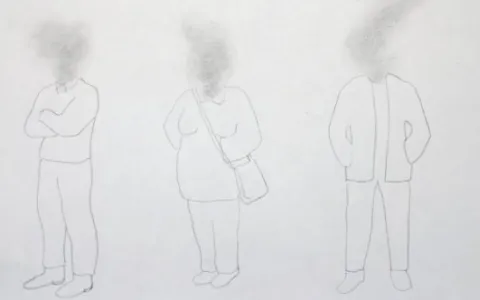Antonio Paucar
His artistic project in the artistic residence mobility programme co-produced by AMIL Project, AECID and Matadero Madrid within the framework of ARCO 2019.
First Project: Installation with drawings on paper on the floor Title: The bridge between South America and Europe
On a piece of paper 30 metres long and 120 cm wide I am drawing a path of human bones that allude to a saying I heard in Potosi: "The legend in Potosí tells that all the silver and gold that was extracted in the colonial period could build a bridge between South America and Spain. The same bridge could be built with the bones of our ancestors who died or were killed in the mine." Imagining the bone bridge, that idea, was overpowering and too dramatic for me. It seems pertinent to me to conceptualize, to remember and on the other hand to update this subject, since at present in the Andes, Amazon and other regions, mining extractivism continues to be the main source of social and environmental conflict, and is a serious health issue. The increase in assassinations of indigenous leaders, environmentalists and communities that defend their lands and water sources against contamination and the appropriation of their resources: water, forests, agricultural lands, and the like, by mining transnationals is worrying.
Second Project: Installation of human figures in the sculpture space. Title: Saying goodbye to the water
I am going to draft a set of figures of people on a human scale, trying to achieve a certain degree of realism. The figures will be made with manipulated mannequins and to provide them with more realism they will wear used clothes acquired in the second-hand markets of Madrid. The pieces will represent common characters taken from the Madrid scene. The sculptures will not have heads. From the opening of the neck of the headless figures will emanate a slight yet constant flow of steam. It is evident that my intention in this work is to conceptualize the vulnerability of the human being and the element of water (in its gaseous state) as an essential element in our body. In this way, I am also interested in discussing the concern of human beings for the growing privatization and scarcity of water, both in Spain and in the rest of the world. These standing figures, where the head has been replaced by water vapour, can poetically transmit complex sensations and intimate emotions to the on-looker.
About Antonio Paucar
Antonio Paucar was born in 1973 in Huancayo, Peru. He lives and works in Berlin, Germany and Huancayo, Peru. He comes from a family of artisans. Since his childhood he has worked as an artisan making traditional Andean figures and masks. After finishing secondary education, he took vocational training in beekeeping and worked for many years as a beekeeper in the Central Highlands of Peru. He then travelled to Berlin where he studied and graduated in Visual Arts at the Universität der Künste Berlin. Paucar was awarded the LARA Prize 2013 and the Kunstpreis Zeitsicht 2011 Art Prize, Augsburg.
Organiza: CRA, Matadero Madrid, AECID y Proyecto AMIL

